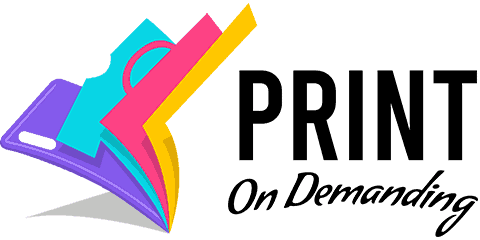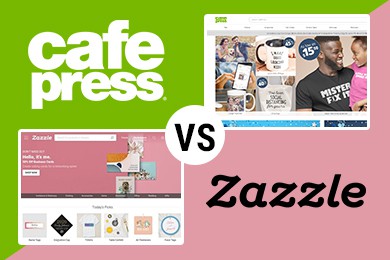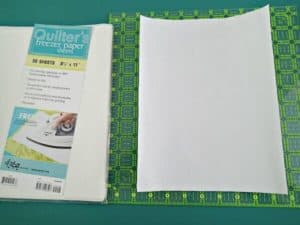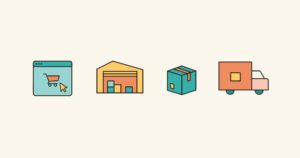
You’ve decided you’d like to print your own merchandise, be that t-shirts, mugs, blankets, phone cases, and more. You might even want to sell the printed content. Two such popular printing services you’ve heard of for these purposes are CafePress and Zazzle. Both seem appealing, but what are the differences between the two? Which is better for you?
The differences between CafePress and Zazzle are as follows:
Still, want to know more about both CafePress and Zazzle so you can choose between them? If so, then you’ve come to the right place. In this informative, instructional comparison guide, we’ll lay out the histories of both companies, their services, and which is the better choice for your printing needs. Let’s get started!
What Is CafePress?
First, we’ll begin with CafePress. Founded in 1999 in San Mateo, California by Maheesh Jain and Fred Durham, the company started as one that was owned in private. CafePress expanded over the years and took home a Webby Award from People’s Voice in 2001 for its commerce work.
With time, CafePress moved its headquarters from San Mateo to Louisville, Kentucky, where it’s still headquartered to this day.
CafePress’s website allows users to sign up and upload works to be printed. These works can include text, a logo, a design, or even all three. They also partner with brands and franchises such as Pepsi and Emoji. If you enjoy Peanuts, Friends, Bob’s Burgers, Game of Thrones, Marvel movies, or Star Trek, you can also get officially licensed products through CafePress’ website.
The items you can get printed are nearly endless. They include signs and stickers such as yard signs, bumper stickers, shaped stickers, and banners. You can also shop for all sorts of stationery at CafePress, including holiday cards, personalized stationery, notebooks, calendars, postcards, announcements, and invitations.
Looking for some drinkware? CafePress has it in spades, with flasks, coasters, shot glasses, water bottles, drinking glasses, insulated drinkware, and mugs all available for printing. You can even decorate the home with CafePress printed goods, including ornaments, magnets, clocks, rugs, pillows, aprons, bathroom items, bedroom items, canvas prints, and blankets.
All the clothes you could ever want to be printed are here as well. These include shirts, pants, leggings, underwear, pajamas, sweatshirts, hoodies, and even bibs and one-pieces for babies and toddlers.
By 2006, CafePress had more than 2.6 million users with their own respective shops on the site. These users produced more than 200 million goods. Several years later, in 2011, the numbers had increased. By then, 13 million people had signed up to use CafePress, offering more than 325 million goods.
CafePress has absorbed companies along the way, such as Imagekind, a photo printing company. They also obtained Canvas On Demand for canvas art printing. Snapfish bought CafePress in 2018 to the tune of $25 million.
What Is Zazzle?
Another printing service option is Zazzle. This company operates in much the same vein as CafePress. It was founded in 2005, so it’s about six years behind CafePress. Jeff Beaver, Bobby Beaver, and Robert Beaver, three brothers, created the company in their garage.
To begin Zazzle, the Beaver brothers had caught the attention of Ram Shriram and John Doerr, two Google investors who funded the start of the company. They lent the Beavers $16 million to get Zazzle off the ground. The brothers also received $30 million further from Shriram and Doerr in 2007 for Zazzle.
It didn’t take long for Zazzle to take off. Also in 2007, the company was declared to have the “best business model” by TechCrunch during their Crunchies awards. By 2010, Zazzle was recognized by Lead411, being called one of their Hottest Silicon Valley Companies. Zazzle has always been based in Redwood City, California.
As we said, Zazzle and CafePress are similar. You can sign up and upload your own content to be printed on nearly an endless array of items on Zazzle’s website. For the newlyweds in your life, there are invitations, wedding programs, thank-you cards, stationery, save the dates, and gifts with customized printing.
Zazzle’s printable office supplies include clipboards, labels, Post-it notes, rubber stamps, binders, notebooks, business supplies, calendars, stickers, and business cards. You can even put your own personal touch on tech items like Apple Watch bands, phone cases, mousepads, laptop cases, and USB flash drives.
Stock up on home goods like custom-printed doormats, serving trays, kitchen towels, pet supplies (like pillows or beds), kitchen aprons, fridge magnets, clocks, bathroom towels, blankets, and mugs and drinkware.
Of course, you have to expect clothing options, too, such as socks, leggings, sweatshirts, hoodies, baby clothes, kids’ clothes, and clothing for women and men. You can even print your own shoes with Zazzle as well as hats, purses and bags, ties, and belts.
Not to be outdone by CafePress, Zazzle has a slew of branded partners it sells goods for as well. Some of these are DC, Peanuts (yes, the company works with both Zazzle and CafePress), Sesame Street, Star Wars, Pixar, and Disney.
How Does CafePress Work?
Next, let’s talk about how both CafePress and Zazzle work. Remember, with both services, you can either make money or spend money. If you spend money, you’d be doing so in a consumer capacity, shopping around the CafePress site and buying any printed goods you like. These goods may be printed with another user’s design or even that of a branded company such as Marvel or Peanuts.
What if you wanted to use the service to make money, such as by selling your own designs? CafePress has a section about how to do just that on their website. If you wanted to print through CafePress, you’d make your own store on their site. Before you officially open your web store, you’d have to sign up for a membership on CafePress’s website. You can use the link we provided at the beginning of this guide for that.
If you have an Amazon account or one on Facebook, you can link either to CafePress so you don’t have to make a new login. You can also register an account the good, old-fashioned way, by using a preexisting email address and creating a new password. It’s free to sign up.
Once you have an account on CafePress, you can do one of three things. You can enter the CafePress Fan Portal, join the Partner Program, or open your own shop.
Fan Portal
The Fan Portal allows you to make products based on your favorite comic book series, movies, television shows, and other franchises. You’re still designing things here, but they’re for someone else’s intellectual property. If you don’t mind that, then you can earn some decent money in the Fan Portal.
Partner Program
Next, there’s the Partner Program, in which you’re a CafePress affiliate. If you aren’t so crafty and creative but you still want some extra cash, then the Partner Program is the perfect option for you. There’s no need to make anything of your own here. Instead, it’s your job to market and promote other products so they get sales.
When someone buys the product, some of that money goes to you as an affiliate. The more products you help sell, the higher your royalties.
CafePress Shop
You may also wish to open your own shop on CafePress. This is recommended if you already have a following, CafePress says. You create and sell the merchandise of your choosing. With more than 450 products at your fingertips to print, produce, and begin selling, you have plenty of options.
The royalties go to you in this case, unless you have an affiliate. There are bonuses that can increase your earning potential even more. How much money can you expect to make? Here’s a page on CafePress’ site that should clue you in.
Let’s say you designed a t-shirt and sold it on CafePress. The average price for a tee on their site is $18. Your mark-up price would be $5. That makes the total price $23, giving you an average of $5 in earnings on one shirt.
As we said before, there’s the potential for bonuses as well. These are issued monthly, and bonus prices increase by tier:
- At the first tier, you get a 10-percent bonus, which is $100.01 to $500 a month
- At the second tier, you get a 15-percent bonus, which is $500.01 to $1,000 a month
- At the third tier, you get a 20-percent bonus, which is $1,000.01 to $2,000 a month
- At the fourth tier, you get a 25-percent bonus, which is $2,000.01 to $5,000 a month
- At the fifth tier, you get a 30-percent bonus, which is $5,000.01 and up a month
If you’re interested in joining the CafePress team, you can watch the CafePress shop account setup process in action via this handy YouTube video:
How Does Zazzle Work?
As is the case with CafePress, you can also shop on Zazzle and spend money as a consumer or you can earn money through this customized printing platform. Before you do that, you need a Zazzle account if you don’t already have one. Just like you did with CafePress, you can use your Google or Facebook accounts and link to Zazzle that way. You can also make your own Zazzle account from scratch with email login and password.
Once you’re signed in, you can become a Designer, a Maker, or an Associate with Zazzle.
Designer
Zazzle Designers are those who create works and sell them on the Zazzle platform. You choose the products you want to print your works onto. These products then appear on the Zazzle website. When a customer finds one of your products and buys it, you get “a percentage of the sale” according to Zazzle.
Again, you’re probably curious how much money you’ll make here. Zazzle doesn’t outline it as clearly as CafePress. Instead, they follow a simple formula. You take the royalty percentage and add that to the base price of your product to get the retail price. Royalty rates can vary, but you do have the freedom to set them.
This is both good and bad. If you pick a royalty that’s too low, the item remains affordable. The chances of the item being sold go up, but you don’t make very much money from it. On the flip side, if you jack up the royalty rate exceedingly high (it can go as much as 99 percent), then the product price reflects that. It’s now so expensive that almost no one will buy it. You’d have to tread carefully.
Here’s a video showing you the ropes of creating a store on Zazzle:
Maker
Your next option is to become a Zazzle Maker. This requires you to utilize the Make Engine, in which you can accept custom orders from customers across the Zazzle marketplace. You create the product to the customer’s specifications, let Zazzle know you’re done, and then they take care of the rest. That includes ensuring the product gets safely into the hands of your customer.
Associate
You can also join the Zazzle Associate Program and fulfill the role of affiliate. Once again, you’re not making anything here yourself, but rather, you’re promoting it so it gets sold. The referral payment rate is as high as 15 percent, which is not too shabby. If you get a volume bonus, then for each sale, you could earn as much as 17 percent more in royalties.
What Are the Differences Between CafePress and Zazzle?
By this point, you’re quite familiar with both CafePress and Zazzle. Now it’s time to expand on the differences between the two printing services that we outlined in the intro. These will help you decide which of the sites to choose.
Product Availability
Both CafePress and Zazzle have thousands of products on their respective sites. If you compare one to another, it would seem like their inventories are essentially the same. You can get art or logos printed on everything from shirts to pants, shoes, canvas, towels, pillows, and pretty much everything in between.
If you look closely enough, though, you’ll see there are some differences in inventory between CafePress and Zazzle. If you’re searching for cake toppers, playing cards, and pacifiers to print, you can’t find those on CafePress.
It was once true that you couldn’t buy things like yoga mats or shower curtains on Zazzle, only CafePress. That has since changed, as those items are available for you to customize and sell on both sites. Thus, Zazzle has more items available than CafePress, although not by a very big margin.
Sure, this is kind of nitpicky, but it’s a difference between the two printing services nonetheless.
Setting Royalties
The differences will become more pronounced going forward. Next, we want to talk about your ability to set royalties as a seller for either CafePress or Zazzle. As we talked about in the last section, with Zazzle, you have the freedom to set your royalties at whatever you want. Just know that your likelihood of making a sale is dependent on how high your royalties are.
On average, most Zazzle sellers set their own royalties so their earning percentages are a deal higher than the product’s base price, between 10 and 20 percent more. Some sellers go as high as 35 percent, but they’re more established and thus more likely to make money.
Now, that’s not to say you can’t choose your percentage when selling through CafePress, because you can. However, there are a few loopholes. You can only select your own percentage when selling through your store. If you don’t have your own online store and just sell something generally through the CafePress website, then your royalties cap off at 10 percent of the overall sales price.
Sure, you could try to encourage your audience to only buy on your store site and not the main CafePress site, but if they forget or just don’t do it, then your earning potential is capped pretty low. There are no such restrictions on Zazzle.
There are bonuses that can increase your CafePress earnings, and we don’t want to forget those. These Shop Performance Bonuses have tiers that are decided based on the asking price for the good in question. Again though, if someone buys a product from you on the general CafePress site, then you don’t see a bonus. The buyer has to shop in your store.
Affiliate Programs
While CafePress and Zazzle both have their own affiliate programs, these two programs aren’t identical. Again, Zazzle has a more open-ended affiliate system set up that’s beneficial for its users. At the very least, you’re earning 15 percent on a sale. Should you get into the Volume Bonus Earning Program, then that commission could spike as much as 30 percent. You only need a referral ID to begin promoting products of your choosing.
Okay, so that’s all well and good, but what about CafePress? You can earn a commission there as well, but your job isn’t to get people to go to individual users’ shops. Instead, your goal is to direct traffic to the main CafePress website.
Also, you cannot use the CafePress affiliate program if you live in New York, Pennsylvania, Illinois, Arkansas, Rhode Island, or Hawaii. It’s not clear if there are such restrictions for Zazzle users, but it doesn’t appear so.
Which Is the Better Service?
The time has come for you to choose between CafePress or Zazzle for your printing needs. Which one should you go with?
To answer that question, we have to ask a few of our own questions. Do you only plan on buying from either of these sites, not making and selling your own goods? If so, then either Zazzle or CafePress are great sites to get custom-printed goods. Sure, there are a few items you won’t see on CafePress’s website compared to Zazzle’s. For the most part, though, you can find the same kinds of goods on either site.
Do you plan on making and selling your own goods to be printed on shirts, pillows, and more? If so, then you’re going to want to be a bit more discerning about which of the two services you choose. Remember, you get far more freedom when it comes to setting royalties if you use Zazzle. You have to be very careful with CafePress, because if your product gets sold through their main site instead of your own personal store, then your earnings potential lessens. You also don’t get a bonus.
Do you want to be an affiliate? If so, then again, tread carefully. With CafePress, the situation is sort of reversed compared to the above. Now you do want to promote the overall site instead of individual seller stores to earn the highest commission as an affiliate. Zazzle makes it easier to promote the way you want to, choosing a product and linking your referral ID to it.
Does that mean Zazzle is necessarily the best service? It certainly has its fair share of fans, as it’s the more popular of the two platforms. We hesitate to say Zazzle is better than CafePress or vice-versa, but facts are facts. It is easier to sell and become an affiliate on Zazzle because there are less confusing, restrictive rules than on CafePress. You can also make more money by setting your own earnings percentage.
That’s not to say you should steer clear of CafePress. If you’re already on CafePress or you’re thinking of joining, it’s still a viable service. You just have to be aware of the rules we’ve outlined in this article when it comes to selling and promoting products as an affiliate. Otherwise, you’re shooting yourself in the foot by earning less money.
Conclusion
CafePress and Zazzle are two services that allow you to upload, print, and sell your goods on just about everything. From phone cases to dish towels, hoodies, pillows, magnets, canvas artwork, and way, way more, the only limit is your creativity.
Zazzle has a slightly bigger inventory, although it’s nothing to sway you either way. What may sway you is the fact that you have a higher earnings potential with Zazzle as both a seller and an affiliate. CafePress is still a great service to consider, but you do have to follow their rules carefully to maximize your income. If you were on the fence between CafePress and Zazzle, we hope this article helped you make up your mind!




